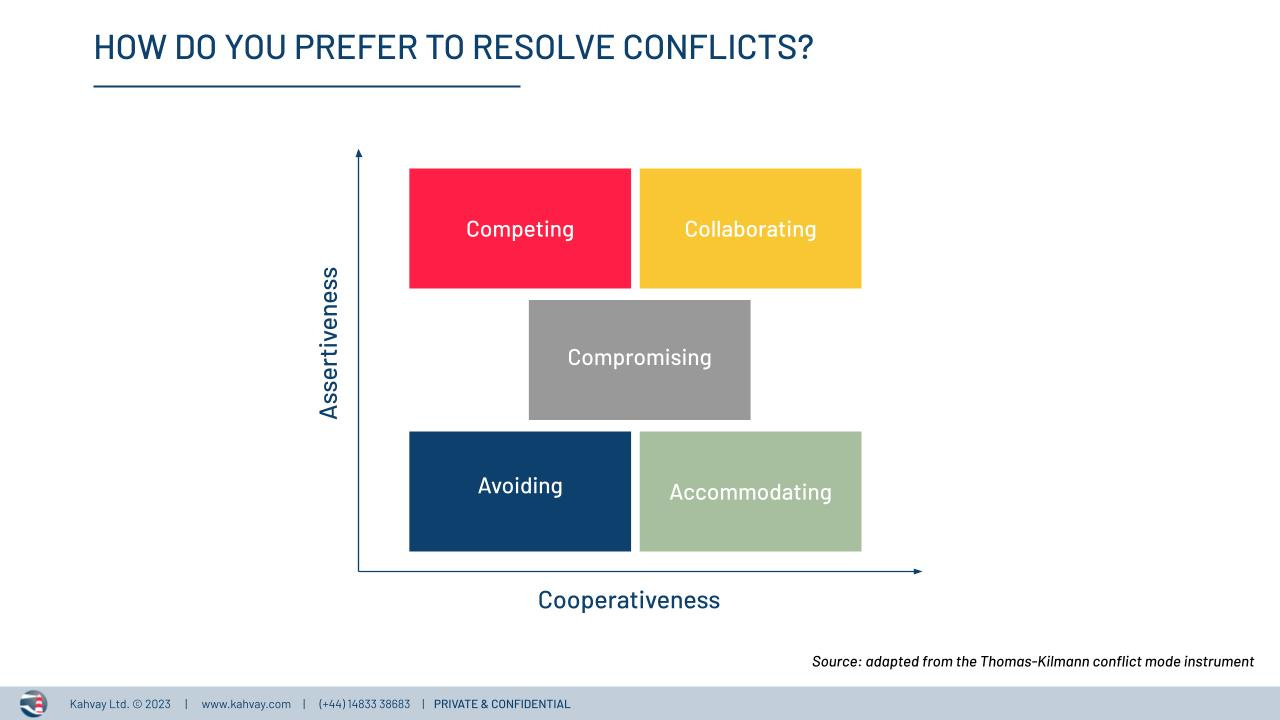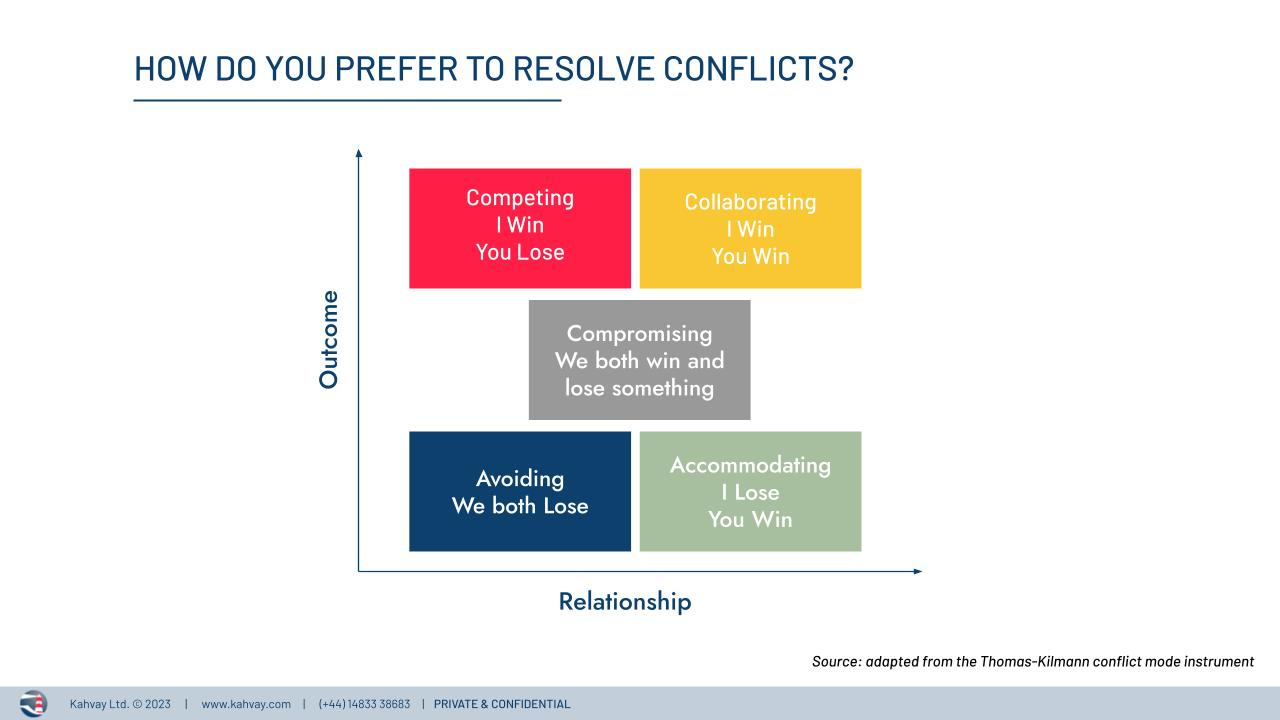TK's Conflict Model: The Good, The Bad, and The Passive-Aggressive
Unpack the Secrets of Conflict Management. Discover Thomas Kilmann’s Conflict Model. Deep Dive into Your Style and Sharpen Your Negotiation Skills.
The Weekly Walkaway highlights negotiation in its ‘good’, ‘bad’ and sometimes ‘downright ugly’ forms. Issue No. 85 (17th July 2024).
Hello negotiation Heroes and Mavericks! Hello you Walkawayers..
It’s Summer and time for The Team to take a well earned break but before we do welcome to this week's issue of The Weekly Walkaway, your go to guide for navigating the treacherous waters of negotiation… because let's face it, who hasn't wanted to walk away from a negotiation at least once this week?
We will be back in September.
So this week, like every family holiday, we're gonna dive into the pool of Conflict Management with Thomas Kilmann's Conflict Model.
Conflict can be of interests or opinions, not just a physical or verbal battle.
Caveat: I’m personally not keen on the model. That's just my humble opinion. Any model that takes our worst behaviour and classifies it into a neat little category is suspect and nothing says "I understand myself" worse than pigeonholing your conflict style for negotiation!
I am a competitor. I am red. I am JFDI.. but I also know that these do not define me. I am all of the types mentioned below and I have learnt to adapt my behaviours to the circumstances I find myself in. I am four dimensional but with a natural tendency towards competitiveness, I am JFDI.
So, as long as you understand that you are all of these behaviours but that you might have a strong preference for one over another and in the right circumstances you will change, then read on…
PAC - Transactional Analysis
Before we do lets just touch on Transactional Analysis (book: by Eric Berne), which explores human social interactions through the lens of psychology. Berne introduces the concept of ‘ego states’… Parent, Adult, and Child… that influence communication and behaviour. The book emphasises understanding and analysing these ego states to improve relationships and personal development. Berne also discusses "transactions" (interactions between people) and "games" (repetitive, unconscious behaviour patterns) to reveal underlying psychological dynamics. The goal is to foster healthier, more authentic interactions by recognising and modifying unproductive patterns.
Oh Phew.. we got that over with.. I’d just like you to keep it in mind.
The Model
In professional services and recruitment, we are juggling egos bigger than Big Ben, that's the bell not the tower, for our US readers..
And so understanding these conflict modes can help us navigate client demands, internal team dynamics, and the occasional meltdown when the coffee machine breaks down.
Much, I believe, can be linked to Parent, Adult, Child, transactional analysis and the games people play to get what they want. (Yes, yes, yes I will do a piece on PAC soon).
For the uninitiated, the Thomas-Kilmann Conflict Model is the brainchild of Kenneth W. Thomas and Ralph H. Kilmann. It's basically a guide to figuring out why your co-worker insists on leaving passive-aggressive notes in the break room.
The model outlines five conflict-handling modes: Competing, yup that’s me, Collaborating, Compromising, Avoiding, and Accommodating. Think of it as a Myers-Briggs but for your inevitable workplace squabbles.
The Five Styles
These might make you chuckle or cringe but remember you are all of these:
Competing: My Way or the Highway - WIN / LOSE or PARENT ego
It’s assertive and uncooperative.. It’s all about me, me, me or win, win, win!
Think of that manager who believes compromise is for the weak. Or that client who sees you as a commodity. They bulldoze through meetings, convinced that their approach is the only approach. That they are all powerful and don’t need you to fulfil their goal. This is your classic Competing style;
Or that someone who swoops in and takes control over a situation. They’re not here to make friends; they’re here to win, to fix a problem, to deliver. Useful when you’re facing a life or death decision or when projects need to be grabbed by the scruff of the neck and shaken until completed or when an executive decision needs to be made, JFDI! It's great when decisive action is needed.
(not me as a hockey player but reminds me of many a good game.. and I’ve the scars to prove it!)
Collaborating: For most this is a Unicorn - WIN / WIN or Adult ego
This is the unicorn of conflict resolution. It’s both high assertive and cooperative, aiming for a Win / Win scenario, and anyone who has worked with me will tell you that Win / Win does not exist. But the unicorn idea is to brainstorm and solve each other's problems, together, mutually. Fact: someone always wins more;
Collaborators are the team players. They want everyone’s input, a harmonious consensus, and maybe a group hug at the end but be warned; it takes a lot of trust to be able to share enough information to make it work. The Negotiators Dilemma is ever present - to compete or cooperate and it's only human nature to protect yourself;
Idealistic? Maybe. Time-consuming? Absolutely. Effective? Often, yes, with the right training and appropriate levels of trust. Oh.. some time wasting traits can be confused with Avoiding, read on for more;
Photo by Michał Parzuchowski on Unsplash
Compromising: Let's Split the Difference and Meet in The Middle - Adult ego
For those who believe life is fair and that if they propose a 50/50 split then that's what they’ll actually get.. Bonkers.. Stuck right in the middle of assertiveness and cooperating. It is in-fact perfect for when you want everyone equally unhappy with the long term outcome, sure to create regret and resentment;
Useful for when you’re tight on time and need a quick resolution or when you need to keep that client happy or when the value on the table is not that high and it’s within your authority to give it to make something else happen.. Can you see how skilled negotiators might use this..?
But if the stakes are high or critical, if there is a clear right / wrong or you're conceding too much, compromising makes you look weak and invites more conflict.
Avoiding: If I Close My Eyes, It Will All Go Away - LOSE / LOSE - Child ego
Yes, it is the classic ostrich manoeuvre. The lowest on both assertiveness and cooperation. It is downright uncooperative! Perfect for those tricky situations where the best solution is to just not deal with it and also, if used well can be misunderstood as collaborating as you burn their time.
Good for deflection or dodging conflict. Useful when the issue has low value or the timing is wrong for you or to allow parties to cool off. Great to delay or even hold issues until you are ready to deal with them, like finding information or gaining authority, as long as you then do deal with them;
Kicking that can down the road just means you’ll trip over it later on. If not managed it is a great way to ensure minor issues become major crises so avoiding critical or recurring conflicts now leads to bigger issues down the line and at best you will be perceived as weak, passive or just plain uninterested.
Photo by Wolfgang Hasselmann on Unsplash
Accommodating: Whatever You Say, Boss - LOSE / WIN - Child ego
The human doormat approach. High on cooperation and lowest on assertiveness. This is for the people who say "yes" to everything and then spend their evenings crying into a glass of wine. Great for keeping the peace;
Putting your own needs below others. It is a sure fire way of being exploited and being taken advantage of but could be useful for customer service or relationship building where client satisfaction is all that matters and this is where many sales people fall over; they just keep giving too much;
Don’t accommodate when the stakes are high and / or the outcome is critical for god's sake! It just invites more conflict. Also if you find yourself always accommodating, it can lead to resentment and imbalance. This can happen in relationships where a PARENT is always in control of a CHILD (PAC - Parent Adult Child - Ego States - I’m OK you're OK - Eric Berne, Transactional Analysis). There are very high risks of exploitation.
Applying the Model
Now, let's talk about how you can use this knowledge to better manage negotiations and conflicts, whether it's with your team or your clients.
Self-Awareness: Know your preferred style. Are you JFDI or a doormat? Understanding your natural inclination helps you adapt your strategy to suit the situation. Recognise your client's conflict style. For example if they’re a competitor, be prepared and understand that behaviour breed’s behaviour, how do you manage The Parent? You wouldn’t want to go Parent to Parent would you? Adapting your approach to manage their style can smooth out many a negotiation sink hole;
Managing your Team's Mix: Each member of your team will have their own natural conflict style. The key is to create a balance. Encourage the Accommodators to speak up and the Competing bulldozers to wait and listen. Create an environment where Collaborators can thrive but keep an eye on the clock to motivate your Avoiders out of endless discussion and prevarication;
Flexibility: Remember, you are all of the above. In a negotiation, you can switch styles based on the situation. Using ‘Conflict’ as a means to manage your counterpart is wholly appropriate. Develop the agility to switch styles as needed. The best negotiators are chameleons, adjusting their strategy based on the stakes, the people involved, and the desired outcome. Flick between your Parent, Adult and Child.
Photo by Ante Hamersmit on Unsplash
Conclusion
Conflict is inevitable. It's messy, it's uncomfortable, and it’s as predictable as that hangover after the office summer BBQ. Understand your style, recognise your client's style, and adjust your behaviour accordingly. It's not about avoiding conflict, it's about managing it and using it to your best interests.
Until next time, have a great Summer Walkawayers, you’ve earned it!
Happy negotiating!
P.S. Remember, if you find yourself in too deep, you can always Compromise by avoiding the accommodation of competing collaborations. Or something like that. Cheers!









